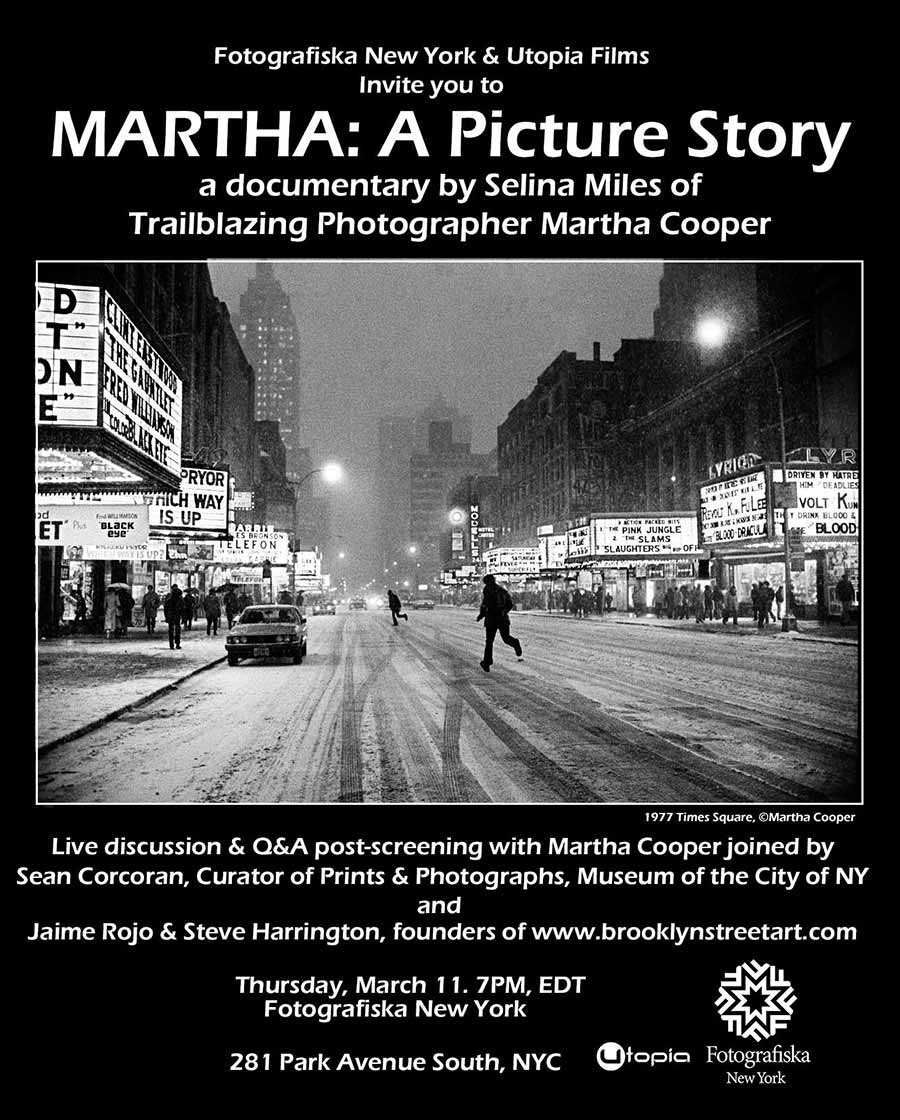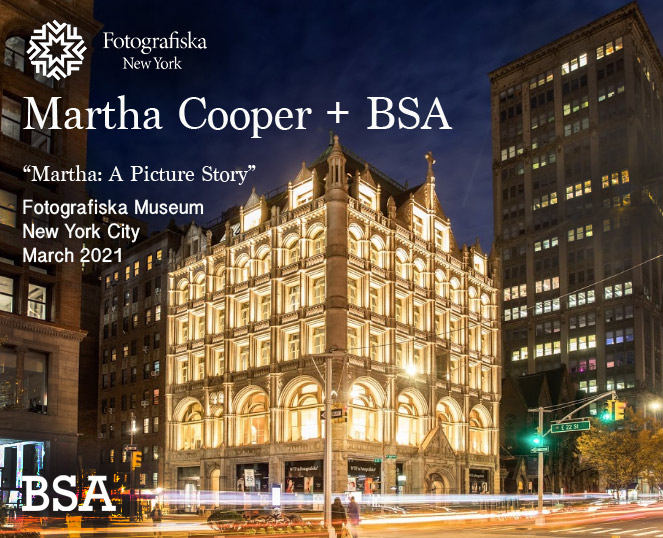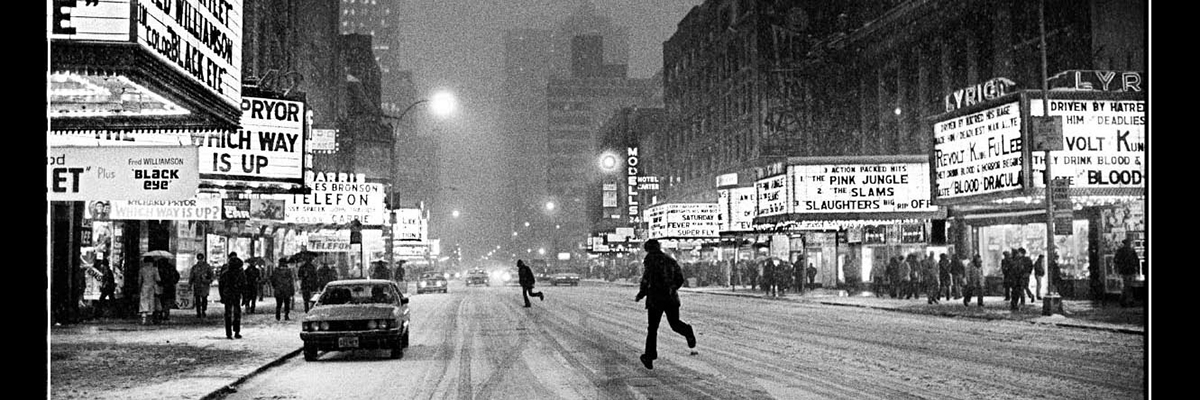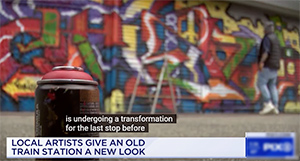It was an auspicious night in New York City, but a very strange one also.
The governor of the state had cleared the way for movies to be seen in theater settings in March, although only at 25% capacity. Fotografiska, a premiere global photo gallery emporium, had invited us after the movie screening to speak with Martha Cooper onstage with Sean Cocoran from the Museum of the City of New York, but there was once catch: everyone had to wear masks. Maybe this has become normal for politicians, but it was odd for all of us. Later when graffiti writer/historian Jay Edlin and artist Aiko joined us onstage, we all were having more fun, but also felt even more claustrophobic.
Chalk it up to experience, as they say. And ultimately it was a true pleasure to share the new cut of “Martha: A Picture Story” by director Selina Miles as it is being released commercially in the US four and a half years after we first suggested to Selina that she might make a documentary about the celebrated photographer in September 2016 in Detroit. The audience appeared to enjoy the film, even though chairs were 6 feet apart, and we even had a book giveaway at the end.
We thank our hosts at Fotografiska for inviting us and for running a great event for Martha and all of us as we emerge from a year locked down.
“For this evening’s screening Martha Cooper was joined in live conversation by Jaime Rojo and Steven P. Harrington, founders of the influential art site BrooklynStreetArt.com and curators of the current “Martha Cooper: Taking Pictures” retrospective exhibition at Urban Nation Museum in Berlin.

Moderated by Sean Corcoran, Curator of Photographs, Museum of the City of New York. Utopia Films’ Martha: A Picture Story is a portrait of trailblazing photographer Martha Cooper – an American photojournalist who became the first female staff photographer for the New York Post during the 1970s, later becoming best known for documenting New York City communities and the graffiti scene of the 1970s and 1980s. Director Selina Miles’ affectionate tribute to Cooper journeys viewers from her snapping shots on a motorcycle trip through east Asia in 1963 at the age of 20, to today, an influential icon to the global movement of street art.”

Recent reviews of “Martha: A Picture Story“
The New York Times
‘Martha: A Picture Story’ Review: Snapshots of a Career
https://www.nytimes.com/2021/03/16/movies/martha-a-picture-story-review.html
ELLE
Martha Cooper Talks to Zoey Grossman about the Art of Photographing Street Art
https://www.elle.com/culture/movies-tv/a35949029/martha-cooper-interview-zoey-grossman/
“Question: When you’re finding the moment within the environment you’re shooting in, do you always go up and ask the people you’re photographing if you can take their photo, or do you try and blend in?
Martha: It depends on the situation. Often if you ask first, you destroy the moment you’re trying to capture. My preference is to be a fly on the wall.
The Los Angeles Times
Review: ‘Martha: A Picture Story’ shares the joy of a septuagenarian NYC street photographer
“But it’s not just her great eye that makes her such an icon on the street art scene; it’s also her unique nerve that led to her photograph so many iconic moments for fans of graffiti, taking risks as she takes photos.”
The San Francisco Examiner
‘Martha: A Picture Story’ celebrates street art
“Documenting street art, which was vilified as an unsightly manifestation of vandalism at the time, Cooper demonstrated that it, in fact, involved imagination, skill, beauty and other qualities connected with art.”
Dazed
“Martha Cooper is the photographer documenting decades of NYC graffiti”
https://www.dazeddigital.com/art-photography/article/52085/1/martha-cooper-has-documented-this-outlaw-art-in-nyc-since-the-1970s
“But, back when Cooper first turned her lens on this ephemeral art form, it was truly anti-establishment. As a potent means of talking back to power, graffiti presented an opportunity for public self-expression and protest. “1977, the Bronx was burning down. No one really wanted to write that graffiti was an interesting thing. But I don’t want to shoot something that’s done with permission,” Cooper explains. ”It’s an outlaw art. That’s what makes it thrilling.”
Rogerebert.com
Nell Minow
https://www.rogerebert.com/reviews/martha-a-picture-story-movie-review-2021
“Decades before the work was taken seriously by the art world, her focus helped the people creating the work think of themselves as artists and it inspired a generation of new artists to express themselves. One of the joys of this movie is seeing these young people treat Cooper as something between a rock star and their grandmother (“maybe mother” she tells one of them).”
See the movie now on Apple TV , iTunes, Altavod, and Amazon
Other Articles You May Like from BSA:
It's part of the fascinating world that you inhabit when you follow street art - you have no idea what you will discover in any city at any time because of it's LIVE daily evolutionary perso...
Here's our weekly interview with the street, this week featuring ASVP, Dain, D. Hollier, Dee Dee, Free Humanity, Homo Riot, Hunt, Jorit Agoch, Myth, Old Broads, Philippe Herard, Solus, The Elect...
Imagine taking a trip with BrooklynStreetArt.com (BSA) founders Steve and Jaime and never leaving your seat as they show you some of the exciting and inventive ideas that are running in the stre...
Street Artist Chris Stain is in Charlotte, North Carolina as the city prepares for the Democratic National Convention coming here on September 3rd. Art on the streets historically has employed politi...
The Gar Gar Festival in Penelles, Spain, is in its eighth edition this year, showcasing street art, muralism, and a new fleet of artists creating pleasant and clever attractions for city walls. “T...
 BROOKLYN STREET ART LOVES YOU MORE EVERY DAY
BROOKLYN STREET ART LOVES YOU MORE EVERY DAY










